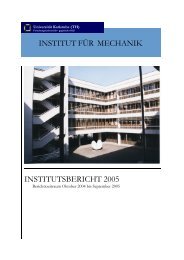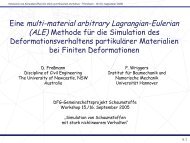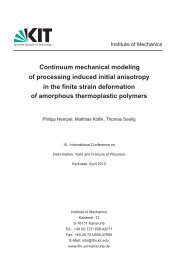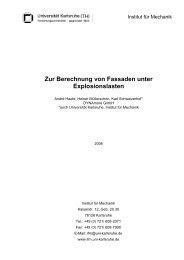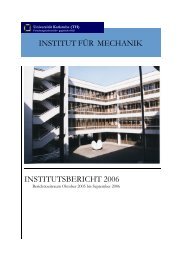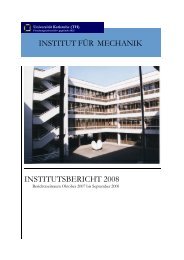dh+1 - am IFM
dh+1 - am IFM
dh+1 - am IFM
Sie wollen auch ein ePaper? Erhöhen Sie die Reichweite Ihrer Titel.
YUMPU macht aus Druck-PDFs automatisch weboptimierte ePaper, die Google liebt.
LITERATURVERZEICHNIS<br />
[86] J. Pitkäranta. The first locking-free plane-elastic finite element: Historia mathematica.<br />
Institutsbericht A411, Helsinki University of Technology, 1999.<br />
[87] J. Pitkäranta. Mathematical and historical reflections of the lowest-order finite<br />
element models for thin structures. Institutsbericht A449 , Helsinki University of<br />
Technology, 2003.<br />
[88] J. Pitkäranta, Y. Leino, O. Ovaskainen und J. Piila. Shell deformation states<br />
and the finite element method: A benchmark study of cylindrical shells. Comput.<br />
Meth. Appl. Mech. Eng., 128:81–121, 1995.<br />
[89] S. Prudhomme, J. T. Oden, T. Westermann, J. Bass und M.E. Botkin. Practical<br />
methods for a posteriori error estimation in engineering applications. Int. J.<br />
Numer. Methods Eng., 56(8):1193–1224, 2003.<br />
[90] S. Prudhomme und J.T. Oden. On goal-oriented error estimation for elliptic<br />
problems: application to the control of pointwise errors. Comput. Meth. Appl.<br />
Mech. Eng., 176:313–331, 1999.<br />
[91] W. Rachowicz, D. Pardo und L. Demkowicz. Fully Automatic hp-Adaptivity in<br />
Three Dimensions. Institutsbericht 04-22, ICES, University of Texas, 2004.<br />
[92] R. Radovitzky und M. Ortiz. Error estimation and adaptive meshing in strongly<br />
nonlinear dyn<strong>am</strong>ic problems. Comput. Meth. Appl. Mech. Eng., 172:203–240, 1999.<br />
[93] E. Rank, H. Düster, V. Nübel, K. Preusch und O.T. Bruhns. High order finite<br />
elements for shells. Comput. Meth. Appl. Mech. Eng., 194:2494–2512, 2005.<br />
[94] R. Rannacher und F.-T. Suttmeier. A posteriori error control and mesh adaptation<br />
for FE models in Elasticity and Elasto-Plasticity. Preprint 07/1997, Institut für<br />
Angewandte Mathematik, Universität Heidelberg, 1997.<br />
[95] R. Rannacher und F.-T. Suttmeier. A posteriori error estimation and mesh adaptation<br />
for finite element models in elasto-plasticity. Proc. Workshop ”<br />
Advances in<br />
Adaptive Computational Methods Mechanics“, Cachan, 17.–19. Sept. 1997.<br />
[96] R. Rannacher und F.-T. Suttmeier. A posteriori error control in finite element<br />
methods via duality techniques: application to perfect plasticity. Computational<br />
Mechanics, 21:123-133, 1998.<br />
[97] M.M. Rashid. Material state remapping in computational solid mechanics. Int. J.<br />
Numer. Methods Eng., 55:431–450, 2002.<br />
[98] J. Riccius. Adaptive Methoden zur statischen und dyn<strong>am</strong>ischen Analyse von<br />
Flächentragwerken mit linearen Finiten Elementen. Dissertation, Institut für Mechanik,<br />
Universität Karlsruhe, 1997.<br />
[99] J. Riccius und K. Schweizerhof. Aspects of hierarchical h–adaptive dyn<strong>am</strong>ic analyses.<br />
Proc. Third International Conference on Computational Structures Technology,<br />
1996.<br />
179



